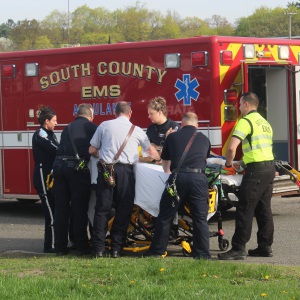Testimony argues against need for Greenfield cell tower

Greenfield Zoning Board of Appeals members listen to testimony Thursday from attorney Andrew Campanelli regarding a proposed cell tower. STAFF PHOTO/ANTHONY CAMMALLERI
| Published: 04-18-2025 5:50 PM |
GREENFIELD — Following testimony from an attorney and a radio frequency expert representing the abutters of a proposed 170-foot monopole cell tower near 112 Newton St., the Zoning Board of Appeals on Thursday formally requested that AT&T provide dropped call data, reception data collected from driving tests and a report from a third-party radio frequency engineer.
Residents who live in the vicinity of the cell tower that is being proposed by applicant Viridi Wireless brought University of New Hampshire Department of Electrical and Computer Engineering Professor Emeritus Kent Chamberlin and their attorney Andrew Campanelli before the ZBA to discuss the potential adverse health effects and alleged lack of necessity.
Although the Telecommunications Act of 1996 makes it illegal for local zoning boards to deny cellphone companies permits or variances based on the perceived negative health consequences, the board allowed Chamberlin to present health data after making note of the fact that it could not use any of the information.
In a slideshow presentation, Chamberlin began by outlining his credentials, which include serving on New Hampshire’s Commission to Study the Environmental and Health Effects of Evolving 5G Technology in 2019, before sharing data linking patients’ proximity to cell towers to higher rates of cancer death.
He went on to argue that wireless communications companies had a chokehold on the main regulatory body, the Federal Communications Commission, at one point depicting images of a tree located in close proximity to a cell tower that had been burned significantly on the side that faced the tower, presumably from radiation.
“If you look at what’s been going on in this country in the past 25 years or more, you’ve seen this very significant increase. Alzheimer’s, for example, has more than doubled since the year 2000. If you look at what’s going on with diabetes, it starts out relatively low in 2004, but then as the years increase, the incidence of Type 2 diabetes has been increasing,” Chamberlin said. “What happened between 2004 and 2012? That’s when the iPhone came out, so we’re seeing these marked increases in these diseases that have been shown to be associated with radiation exposure.”
Chamberlin argued that wireless internet, which is powered through a tower and results in a larger release of radiation, is the main motivation for wireless communication companies’ requests to build cell towers in residential neighborhoods.
Chamberlin also referred to dropped call data, which AT&T previously told the ZBA it would not release because it is “proprietary information,” as the “gold standard” for proving evidence of a coverage gap. When first responders came before the ZBA last week, they argued that the applicant’s alleged coverage gap in the area of Newton Street and Interstate 91 is real and has made their jobs more challenging.
Article continues after...
Yesterday's Most Read Articles
 Northfield man dies in Erving motorcycle crash; Bernardston man injured in Deerfield crash
Northfield man dies in Erving motorcycle crash; Bernardston man injured in Deerfield crash
 Garage, house sustain ‘major damage’ in Phillips Street blaze in Greenfield
Garage, house sustain ‘major damage’ in Phillips Street blaze in Greenfield
 Extension cord under hay ‘being considered a potential factor’ in Leverett house fire
Extension cord under hay ‘being considered a potential factor’ in Leverett house fire
 Lesbian bar opens in Greenfield: Last Ditch is the new space for the Valley’s queer community
Lesbian bar opens in Greenfield: Last Ditch is the new space for the Valley’s queer community
 Real Estate Transactions: May 2, 2025
Real Estate Transactions: May 2, 2025
 New Salem town coordinator stepping down
New Salem town coordinator stepping down
Chamberlin noted the coverage maps that AT&T shared with the board differ greatly from those obtained from the FCC, which are drafted through dropped call data.
“If you look at the maps that are provided … you should see it may show this gap in coverage,” Chamberlin said. “What’s pretty clear to me is that you have the plenty of signal in this area right here. You don’t have an issue. You don’t need another tower, unless you want to bring in 5G home internet.”
Campanelli, too, questioned the validity of AT&T’s coverage maps, accusing the company of using “bait and switch” tactics to demonstrate a coverage gap where there is none. He added that the ZBA has every right to request drive test data or dropped call data from the applicant, adding that he feels the maps shown would not hold up in front of a judge and are not based on any real data.
“I could prepare a map showing you the locations of all Chuck E. Cheeses located on the Gaza Strip in Israel. It would be completely untethered from reality, but I can give it to you. The maps they provided you have no data backing them,” Campanelli said. “The maps that they’ve given you would not be admitted as evidence in any federal or state court. Nobody’s verified these maps — they don’t claim they’re based upon actual data. They are desktop-created maps. Somebody sat at a computer desktop … and just created a coverage map without the data it was created from. It’s the functional equivalent of giving a child three colored crayons and asking them to color a map on a piece of paper.”
The attorney also refuted claims of a coverage gap, noting that in the absence of 5G connection, cellphones “downshift” to different frequencies such as 4G and 3G. Campanelli cited federal court cases from across the country to note that a judge will, in a court of law, side with municipalities over requests to see dropped call data to prove a coverage gap.
Noting that the variance before the board would allow the company to build a cell tower in a residential zoning district, Campanelli also cited examples of cell towers collapsing and falling outside their designated “fall points.” He referenced and questioned the applicants’ previous remarks that the tower would be constructed with a “pinch point” or weak spot in the middle to ensure a clean break in the event of failure.
“There’s a reason that all municipalities across the United States post setback zones for cell towers. In most cases, the standard is 110% of the height of the tower to protect against the dangers of structural failure,” Campanelli said, citing an instance in which a 165-foot tower collapsed, striking a fire chief’s vehicle only two weeks after it was erected. “There are plenty of examples where cell towers collapse from a distance greater than the actual height of the tower. … If they can’t build the towers to stand up in the first place, what makes you think they’ll be any better at making them fail the way they want them to fail?”
Both presentations were met with significant public comment in which abutters expressed a strong opposition to the tower, voicing skepticism over the claim that there is a coverage gap.
In a brief rebuttal, attorney Michael Rosen, who represents Viridi Wireless, the company building the tower for AT&T, pushed back against claims that the company has been deceptive to the board and offered to pay $5,000 for the city to hire a radio frequency engineer.
In deliberations, the board agreed to take Rosen up on his offer and voted unanimously to formally request that the applicant hand over dropped call data and reception data collected from driving tests, and hire a report from a third-party radio frequency engineer to study the need for coverage in the area.
The ZBA will next discuss this issue at a May 8 meeting.
“I want to make the best decision that we can make,” ZBA Chair David Singer said. “At the end of the day, I want to look at everybody and say, ‘We made the right decision,’ because we had all the information that we needed to do so.”
Anthony Cammalleri can be reached at acammalleri@recorder.com or 413-930-4429.






 Antique truck show celebrates 20th year in Deerfield on Sunday
Antique truck show celebrates 20th year in Deerfield on Sunday Petting zoo brings joy to families in Orange
Petting zoo brings joy to families in Orange $200K grant fuels expansion at Radial Dynamics in Greenfield
$200K grant fuels expansion at Radial Dynamics in Greenfield
